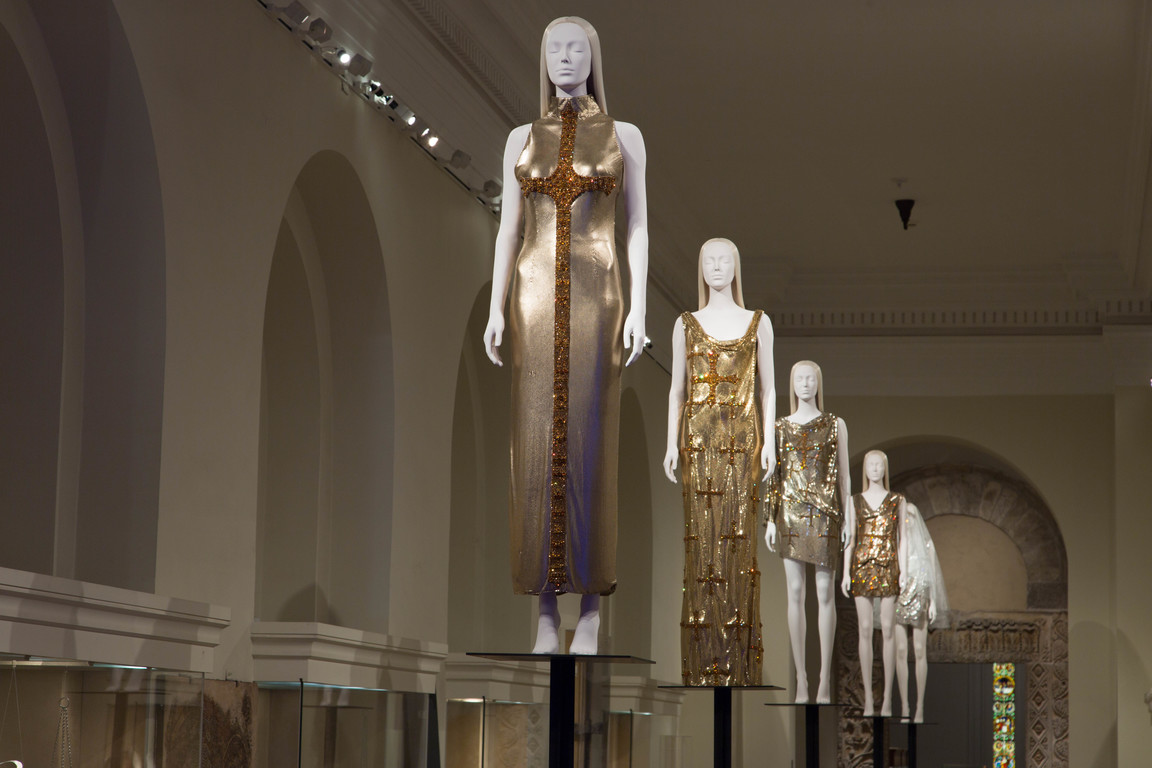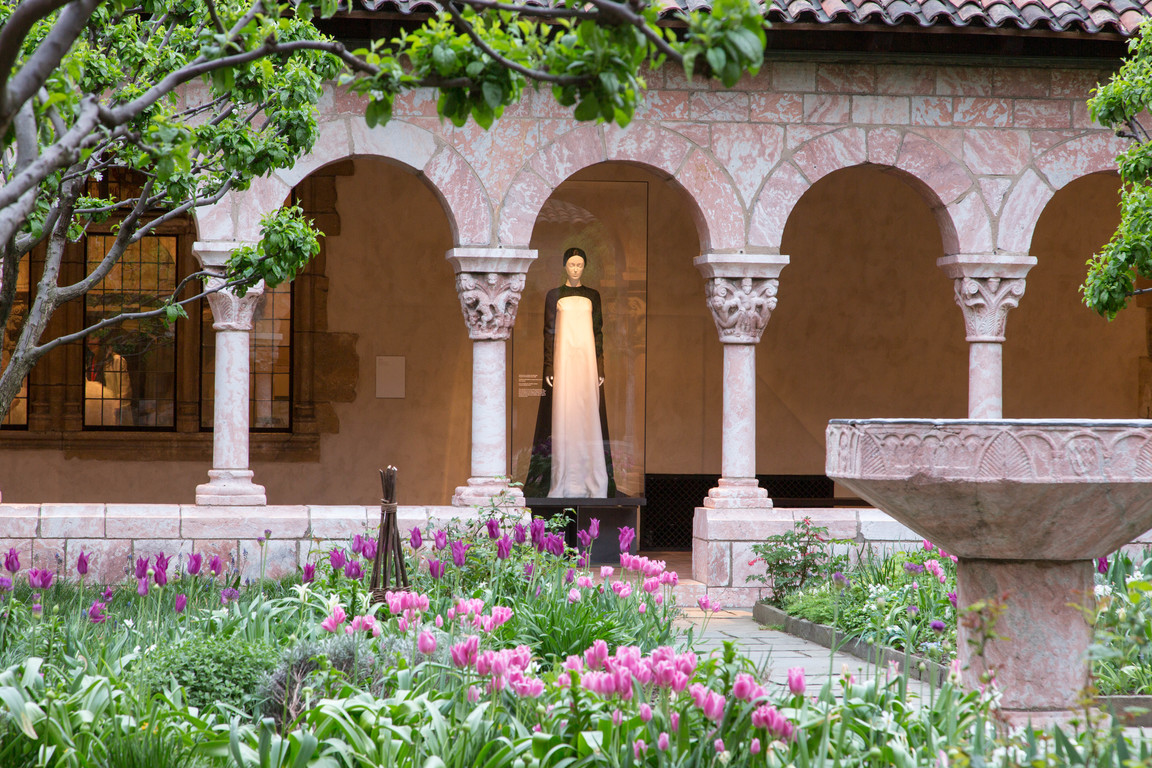A powerful tension exists in the role and meaning of the body, of materiality, and of beauty in Catholic theology, history, and practice. Sumptuously adorned bodies, the presence of the sacred within material form, and the use of rich color and images to represent the splendor of God and the heavens coexist with theologies of sin and purity that pit carnality against the spirit in a never-ending battle. The former sanctifies physicality while the latter relegates it to a burden humans must bear and ultimately overcome. In one sense, Heavenly Bodies: Fashion and the Catholic Imagination is an extended meditation on this paradox. The exhibit displays Catholic-influenced modern fashion design alongside medieval Catholic art and vestments, a juxtaposition that has been fundamentally shaped by contradictory Catholic approaches to materiality and embodiment.
The visual and material repertoire of Heavenly Bodies has also been fundamentally shaped by the role of allegory in Catholic theology and visual culture. Taking the importance of analogy and allegory into account, seemingly incommensurable pairings no longer appear to simply represent contradictory strains of Catholic thought. On one hand, the body, understood literally, is something to control; physical desires and longings, understood literally, are things to fear and rise above; material beauty, luxurious texture, color, and form, in and of themselves, are at best, petty distractions, and at worst, sources of temptation through which Satan can awake carnal appetites that threaten the soul’s eternal salvation. On the other hand, these things, when they serve as an allegory for God’s love, God’s truth, and God’s majesty, can be spiritualized and made sacred. They become the Church’s most powerful tool for attracting and teaching the faithful, and its most powerful weapon for fighting Satan’s sinister influence.
What sustains this paradox in the everyday life of the Church is the strain of Catholic thought that holds that while the spiritual and intellectual elite do not need visual and material symbols to access true knowledge about God and the heavens, the vast majority of the faithful do. Medieval Catholic pedagogical methodology was committed to the idea that earthly and material beauty, though it paled in comparison to God’s true splendor, was essential for teaching people about God. The Council of Trent (1545-1563) strengthened this idea, insisting that luxurious clerical vestments, elaborate ecclesiastical architecture, and the generous distribution of religious art, symbols, and images were indispensable for guiding the faithful. But the Tridentine fathers also articulated the dangers involved in the use of material beauty to inspire an embodied and emotional experience of the wonder and majesty of divine truths. In this way, the simultaneous elevation and fear of the body, the aesthetic impulse toward both extravagant beauty and radical simplicity, the contradictory meanings assigned to colors, light, and darkness became and have remained literally woven into the fabric of Catholic culture.
All of this has had profound implications for gendered bodies and the social beings who inhabit and encounter them. In the first volume of the Heavenly Bodies catalog, David Tracy explores “the Catholic analogical imagination” through a discussion of the theological work of Renaissance artists, particularly Michelangelo. An awareness of the importance of analogy in Catholic thought, Tracy argues, allows us to see Michelangelo as a theologian working in a visual idiom. What happens when we read Catholic-influenced fashion design through the same lens? What theological work are renowned designers such as Versace, Dolce, Gabbana, Gaultier, Schiaparelli, Lanvin, and others doing in their evening ensembles modeled after the ceremonial vestments of cardinals, or headdresses and gowns that transform a mortal woman into a near replica of the Virgin Mary as Queen of Heaven, or the dramatic but modest clothing made for a female body but resonant of a medieval monk? If we take seriously the idea that there is such a thing as “a Catholic imaginary” and that central to this imaginary is an allegorical relationship between material beauty and heavenly truths, then fashion designs using religious themes, ecclesiastical forms, and biblical references are not irreverent or sacrilegious appropriations. Rather, this clothing becomes an innovative theological statement, a modern translation of longstanding Catholic doctrine insisting on the pedagogical importance of material and visual analogical representations of heavenly splendor and divine majesty.
Fundamental to this translation is the change of canvas from the ecclesiastical male body to the lay female one, as well as from the de-natured female saint’s body to the idealized but otherwise ordinary human female body. Indeed, the experience of wonder, surprise, humor, reverence, or for some, unease the exhibit provokes has much to do with the bending and borrowings across gender and the way these practices alter the allegorical function of the visual forms viewers are seeing. In his essay in the second volume of the exhibit’s catalog, David Morgan says that “in Catholic imagery of sacred persons, garments take a primary role in transfiguring the body, concealing it to transform the flesh and bone of mortal human existence into an instrument of grace.” Morgan further explores the embodied experience of the viewer encountering the allegorical intentions of sumptuous clothing on the male bodies of the Catholic hierarchy and in images of the Virgin Mary. What, then, does it reveal or trouble when a medieval clerical visual repertoire is used on clothing meant to adorn the modern female body? What does it mean when Catholic impulses toward restraint, simplicity, self-denial, and control, as well as those toward celebrations of majesty, splendor, extravagance, and even ecstasy, show up on apparel meant for women? Until the nineteenth century, both sets of impulses were available in some important ways to the spiritual elite among both men and women but today, in the Church, it is only male clerical bodies that are adorned in allegorical splendor. Images of female saints and the Virgin Mary still abound and they, like clerical vestments and ecclesiastical architecture, still make up part of the visual landscape for both Catholic women and men. But the visual and material splendor of the Roman Catholic hierarchy—expressed in clothing and Vatican spaces occupied only by those of high office in the church—is arguably even more exclusively male than it once was.
In the context of this starkly gendered reality, the exhibit challenges viewers to recognize the innovative theological possibilities of fashion design. Designs like Jean Paul Gaultier’s spring/summer 2007 “‘Ex-Voto’ Evening Ensemble” or Cristobal Balenciaga’s 1951 “Evening Dress” render the female body splendidly visible through forms meant, in their original context, as allegories for divine beauty, majesty, and grandeur—either in religious art or clothing for male clerics. Equally suggestive are designs like Viktor Horsting’s autumn/winter 1999-2000 “Ensemble,” which hide the female body, burying it within forms normally seen adorning sacred beings or ecclesiastical authorities, elevating the wearer to the level of cardinal, bishop, or saint. In still another theological idiom, designs like Gianni Versace’s autumn/winter 1991-92 “Evening Ensemble” do not resemble clerical or sacred clothing in their form or material, but the highly modern styles are embellished with clear and literal religious images and symbols.
When performers such as Madonna and Lady Gaga entangle Catholic imagery with representations of sexual desire and physical sensuality, the power of the emotional and visual impact does not lie in sacrilege, but rather in laying bare the Catholic imagination in the most logical way for the context of modern society. What is the ultimate representation of beauty for late twentieth century Western culture if not the image of an exquisitely rendered woman that resonates with dominant visual ideals? A gorgeous woman in gorgeous clothing understood simply as a beautified and well-adorned female body can be read as an expression of vanity or a stimulus for lust. But as religious allegory, couldn’t such a body be used as a way to give modern viewers visceral access to something approximating heavenly splendor, spiritual bliss, and the majesty of God’s creation? Is this not the extension of the allegory logic for the twentieth and twenty-first centuries?

Galleries for Byzantine Art.
Image: © The Metropolitan Museum of Art
Seen this way, the juxtaposition of modern women’s fashion with medieval costume and art does not appear controversial or sacrilegious, as much as it does a modern translation of the allegorical Catholic imagination. The results of this translation are diverse, however. Evening dresses that employ religious imagery, but which reveal the shape of the female body—like Gianni Versace’s autumn/winter 1997-98 “Evening Dress” (see Fig. 1) and Maria Grazia Chiuri and Pierpaolo Piccioli’s spring/summer 2014 “Evening Dress“—evoke different “truths” than do ensembles in which the body is mostly hidden by sumptuous material recalling clerical vestments, such as Chiuri and Piccioli’s autumn/winter 2015-16 “Evening Ensemble” and Balenciaga’s autumn/winter 1948-49 “Evening Cape.” Yet another “message” is conveyed by designs that look like outfits meant for fashionable female cardinals—like Domenico Dolce and Stefano Gabbana’s autumn/winter 2016-17 “Evening Ensemble” and John Galliano’s autumn/winter 2000-01 “Evening Ensemble.”
We might describe some of these designs as women’s fashion using religious imagery and symbol, and others as clerical fashion made primarily for women’s bodies.1However, Demna Gvasalia’s two spring/summer “ensemble”s were designed for men. In point of fact, some designers, like Balenciaga, created both women’s clothing and official ecclesiastical garments, and some, like Yves Saint Laurent and Riccardo Tisci, created fashion for both the runway and actual statues of saints. Saint Laurent and Tisci’s work sometimes mixes clerical garb with clothing, jewelry, and headdresses seen in medieval representations of the Virgin Mary or angels, as do Saint Laurent’s 1985 “Statuary Vestment for the Virgin of El Rocio” and Tisci’s 2015 “Statuary Vestment for the Maddonna Delle Grazie.” Other designs transform the human female body itself into the Virgin Mary, a famous saint, or a heavenly angel, as do Thierry Mugler’s autumn/winter 1984-85 “Evening Ensemble” and his autumn/winter 1984-85 “Dress.” Such designs remind us that medieval ecclesiastical dress shared a visual repertoire with artistic renderings of the Virgin Mary. They also call to mind the artistic and textual tradition of holy male bodies represented as female (in the form of Christ as lactating for the nourishment of his followers or priests rendered as the brides of Christ, for instance), even as they disrupt the male body’s monopoly on representations of divine splendor.

Image: © The Metropolitan Museum of Art
Distinct in some important ways from the designs that use women’s clothing to reflect heavenly majesty, are those that draw from both male and female Catholic monastic traditions. In works like Valentino SpA and Pierpaola Piccioli’s two autumn/winter 2017-18 “Evening Ensembles” (Fig. 2) and Balenciaga’s 1967 “Raincoat,” we see female bodies fashioned as a monk, hermit, or male monastic saint, sometimes in highly direct ways. Clothed in material and colors invoking images of itinerate preachers and mendicant friars, the female body is given unusual authority through visual cues that, for medieval men, were meant to convey poverty, humility, and a particularly masculine kind of sacrificial virtue.
Heavenly Bodies is far more than a provocative exploration of religious pastiche in high fashion or a visually interesting rendering of historical echoes in the work of renowned Catholic designers. The collaboration between theologians, fashion designers, and curators has produced a visual and written resource that demands a fundamental rethinking of the theological possibilities of allegory and analogy in modern Catholicism and Catholic influenced culture. Through the example of modern fashion designers, and in particular their work meant to adorn female bodies as, or transfigure them into, sacred beings, images, and symbols, Heavenly Bodies presents us with a living manifestation of a Catholic imaginary formed as much by theological and doctrinal traditions as aesthetic practices and sensibilities.












